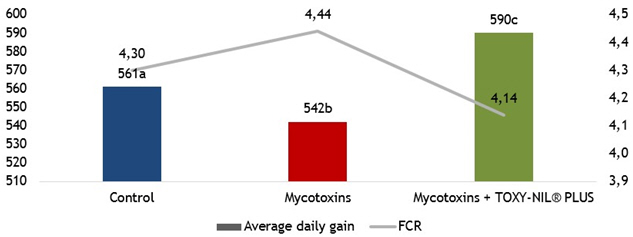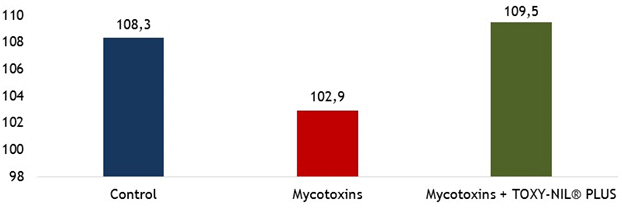



Efficacy of TOXY-NIL PLUS in Fattening Pigs Diets
The addition of a mycotoxin deactivation product, TOXY-NIL PLUS, to a feed with mycotoxins resulted in significant improvements in weight gain and feed conversion compared with the mycotoxin-contaminated without the additive and the mycotoxin-free control groups.Introduction
Mycotoxins are secondary toxic metabolites of moulds and can be found in every variety of grains and forage produced for food or feed. They accumulate in food and feed crops in the field, during transportation or improper storage. Mycotoxins may be present in a feedstuff despite negative analytical findings. It is well understood that mycotoxins are not homogenously dispersed in feedstuffs but usually occur in “hot-spots”. This makes sampling difficult and the mycotoxins may stay analytically undetected, even with perfect sampling procedures. Therefore, a negative result should not be too comforting in many situations.
Mycotoxins may also be masked from analytical detection by small molecules (glycosides) attached to the toxin thus giving a false negative result. Consequently, these masked mycotoxins are not detectable with conventional analytical methods. However, the attached molecules may be removed during digestion, releasing the mycotoxin to affect the animal. It is well documented that mycotoxin consumption causes a decrease in performance including decreased growth rate and poor feed efficiency in pigs.
Generally, pigs are more sensitive to mycotoxins than any other farm animal. Aflatoxins suppress the immune system and the first sign of aflatoxin contamination in the diet is decreased feed intake. Clinical signs, depending on the contamination level can range from reduced growth, to hepatosis, to death.
Among the trichothecenes, deoxynivalenol and T-2 toxin are the most relevant for the pig industry. T-2 toxin inhibits feed intake. Deoxynivalenol also reduces feed intake, decreases growth of the pigs and causes vomiting. Ochratoxins are hepatotoxic and nephrotoxic and cause other particular chronic toxicities. The effects of ochratoxin intoxication are reduced growth, decreased weight gain and renal lesions. Zearalenone mainly causes estrogenic effects in pigs. In pregnant sows, it increases the occurrence of abortions and stillbirths. In others, zearalenone contaminated feed induces swelling and reddening of vulva, false heats and false pregnancy. Fumonisins cause pulmonary edema in pigs. The target organs of fumonisins are the immune system, liver, lungs and pancreas.
The gastrointestinal tract represents the first barrier against ingested chemicals, feed contaminants and natural toxins. Direct intestinal damage can be exerted by the biological action of mycotoxins. Mycotoxins affect the intestinal mucosa, nutrient absorption in the intestine, intestinal secretions and motility. Pathogen colonisation is enhanced while beneficial bacteria are affected by mycotoxins.
There are two practical ways to combat mycotoxin problem:
- the contaminated feed should be replaced with mycotoxin-free feed or
- application of the mycotoxin-deactivating agent.
TOXY-NIL® PLUS is a comprehensive and cost-effective solution to deactivate mycotoxins and minimise their negative effects in animals.
TOXY-NIL PLUS benefits:
- Effective protection against broad spectrum of mycotoxins
- Supports animal immune and antioxidant system, and
- Improves animal fertility and performance.
Experimental Design
The study was conducted with 21 growing pigs. Each group consisted of seven pigs with average group bodyweight 34.4 to 34.5kg. Feed was given to all groups ad libitum and the access to water was free. The trial design was following:
- Control: good quality compound feed
- Mycotoxins: feed contaminated with aflatoxin B1, ochratoxin A and zearalenone through mouldy barley
- Mycotoxins + TOXY-NIL PLUS: same feed as in the contaminated group with inclusion of TOXY-NIL PLUS at 1.5kg pet tonne.
Barley was used as a source of mycotoxins. Control feed was based on good quality barley. Barley in feed of other groups was mouldy. Contaminated diets contained 1.5ppb aflatoxin B1, 110ppb ochratoxin A and 660ppb zearalenone.
Results
From the results shown in Figure 1, it can be concluded that the presence of mycotoxins in feed negatively influenced the average daily weight gain of pigs and feed conversion rate compared with animals in the control group (-19g per day and +0.14, respectively; P≤0.05).
The addition of a mycotoxin deactivation product, TOXY-NIL PLUS, to the feed with mycotoxins resulted in a significant improvement of both parameters compared with the contaminated and the control groups.

a,b Averages in the columns with different superscript letters differ (P≤0.05)
Mycotoxin contamination of feed led to the reduction of the final weight by 5.4kg (Figure 2). Pigs offered the diet containing TOXY-NIL PLUS had final weight +6.6kg compared with the contaminated group and +1.2kg versus control.

Apparently, feed in the control group also contained low levels of mycotoxins. This can explain better performance of pigs fed contaminated feed with TOXY-NIL PLUS in comparison with the control pigs fed good quality feed.
Conclusion
Results of this trial showed significant influence of mycotoxins both at low and high levels on the performance of fattening pigs.
With TOXY-NIL PLUS, the producer can achieve substantial cost savings due to higher final weight of pigs and improved feed conversion rate.
By not underestimating the negative effects of mycotoxins in livestock, we might significantly improve animal health, leading to additional profit from increased animal performance.
March 2015








